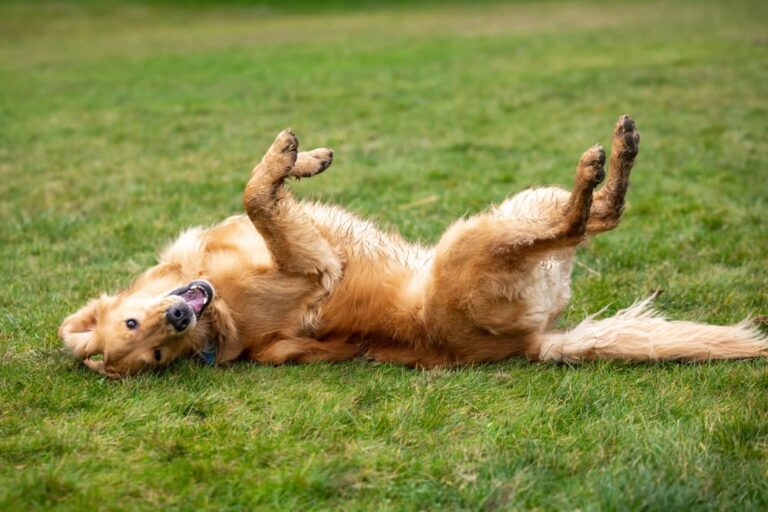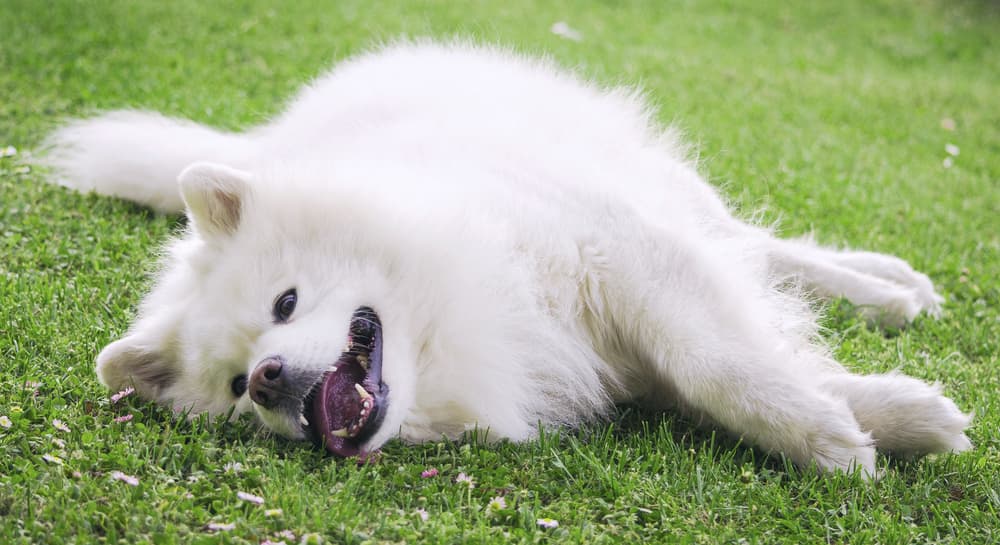Why Do Dogs Roll in Grass?

Overview
- It is normal for dogs to roll in grass, but there are a few things you should look out for
- If the rolling becomes excessive or obsessive, contact your veterinarian
- Dogs typically roll in the grass to transfer or disguise their scent, cool down, or relieve discomfort...or simply because it's fun!
- There are a few things you can do to handle a dog that rolls in the grass excessively, such as redirecting and rewarding
- Keep an eye out for any pesticides in the grass, as well as allergies or irritation your dog could be experiencing
What has four legs and loves to roll in the grass? Dogs, of course!
We know what you’re thinking: why do dogs roll in the grass? While every dog is different, it’s pretty common for them to plop down on the lawn and swivel their bodies about. Oftentimes for a dog, rolling around in grass is just plain fun. Or, the behavior might have to do with scent, body temperature regulation, or comfort.
Your dog’s grass-rolling tendencies are usually nothing to worry about, but there are some things you should look out for. Read on for what you need to know about why dogs roll in grass.
Dogs Rolling in Grass: Is It Normal?
According to Dr. Jeremy Kimmelstiel, the regional medical director at Bond Vet in New York City, grass rolling is considered “a normal behavior in dogs,” but the frequency and context of the behavior may vary.
“Some dogs may roll in the grass more frequently than others,” says Dr. Kimmelstiel, “and it can depend on factors such as their individual preferences, the environment they are in, and their overall level of comfort and contentment.”
Dr. Nicole Savageau, a veterinarian with The Vets mobile veterinary service, says grass rolling is a typical behavior related to instinct. “However, if a dog excessively rolls or exhibits obsessive or compulsive behaviors associated with grass rolling, it may be a sign of underlying issues such as allergies, skin problems, or behavioral concerns,” she adds. “In such cases, consulting with a veterinarian or a professional dog behaviorist can help determine the cause and provide appropriate guidance.”
Why Do Dogs Roll in Grass?

So, why do dogs roll in the grass? According to Dr. Savageau, there could be several reasons for this behavior, the first having to do with scent. “Dogs have scent glands in various parts of their bodies, including their neck, shoulders, and back,” she says. “Rolling in the grass allows them to transfer their scent onto the grass, effectively marking their territory. This behavior communicates to other animals that the area has been claimed by the dog.”
Similarly, she says a dog rolling in grass may be trying to disguise their scent. “By rolling in different odors found in the grass, such as the scents of other animals or plants, dogs may try to camouflage their natural odor, potentially making it more difficult for predators to detect them or prey to recognize them.”
Dogs may also roll in the grass to cool down, especially in the warmer months. “Dogs regulate their body temperature primarily through panting, but rolling in the grass can also help them cool down on a hot day,” Dr. Savageau explains. “The grass can provide a cooler surface for them to lie on and potentially alleviate discomfort caused by heat.”
Additionally, a dog might roll in the turf to try and relieve discomfort from allergies, parasites, or skin conditions, says Dr. Savageau, adding, “It can provide them with temporary relief from discomfort by scratching their bodies against the grass.”
On the other hand, dogs may roll in the grass for no reason other than to enjoy it. “The texture of the grass against their fur, the sensation of the ground beneath them, and the freedom to roll around can provide sensory stimulation and a source of fun and relaxation for them,” says Dr. Savageau.
What to Do About a Dog Rolling in Grass
Dr. Kimmelstiel says grass rolling isn’t cause for concern in most cases. But there are some situations in which you should pay attention. Here are a few tips for handling a dog that revels in rolling.
Redirect and reward. If you want to discourage your dog from rolling in the grass, you can try and limit their access to the grass they tend to roll in, or redirect their attention to other activities or play areas, according to Dr. Savageau.
She adds that positive reinforcement techniques can also be helpful in these situations.
“When your dog is engaged in activities other than grass rolling, such as playing with toys or following commands, praise and reward them with treats or verbal cues. This helps to reinforce desired behaviors and shift their focus away from grass rolling.”
Consider outside training. According to Dr. Savageau, it might be worth enrolling your dog in training sessions to reinforce “basic obedience commands and impulse control.”
And keep it consistent. “Remember, consistency, patience, and positive reinforcement are key when trying to modify your dog’s behavior,” she adds. “It’s important to approach training with understanding and avoid using punishment or harsh methods, as these can have negative effects on your dog’s well-being and the bond you share with them.”
Contact a professional if needed. “If a dog excessively rolls in the grass, to the point of neglecting other activities or displaying signs of discomfort or distress, it could be a behavioral problem or indicate an underlying medical concern,” says Dr. Kimmelstiel. “It is always a good idea to observe your dog’s behavior and consult a veterinarian if you have any concerns.”
Other Tips and Advice

While a dog rolling around in grass is usually nothing to worry about, it can indicate an underlying medical or behavioral issue, as discussed above. But there’s something else you should be cautious about when your dog gets ready to roll: grass that’s been chemically treated.
“When it comes to dogs and grass, it’s generally a good idea to ensure that the grass your dog is rolling in is free of pesticides or harmful chemicals,” says Dr. Kimmelstiel. “Regularly check your dog for any signs of discomfort, such as itching or skin irritations, especially if they frequently roll in the grass.”
Dogs can also be allergic to grass pollens and other plants like humans, and Dr. Savageau says these allergies lead to various symptoms, including:
- Itching, particularly on their paws, bellies, or face
- Redness and inflammation that can result in hot spots, rashes, skin infections, or itchy, red eyes
- Sneezing and respiratory symptoms, such as coughing and nasal congestion
“If you suspect that your dog may have a grass allergy, it’s recommended to consult with a veterinarian,” says Dr. Savageau. “They can perform an examination, review your dog’s medical history, and conduct tests to determine the specific allergens causing the reaction. Treatment options may include allergy management strategies, such as avoiding exposure to grass allergens, medications to alleviate symptoms, or allergen-specific immunotherapy (allergy shots) to desensitize the dog’s immune system.”
According to Dr. Savageau, other things you can do to help dogs deal with allergens and irritants in grass include:
- Grooming them regularly
- Wiping them off with baby wipes or hypoallergenic wipes after they roll in grass
- Feeding an AAFCO approved complete and balanced diet
- Offering stimulating activities to help keep their focus away from grass
“Remember, every dog is unique, and what works for one may not work for another,” Dr. Savageau warns. “It’s important to observe your dog’s behavior, consult with your veterinarian when needed, and tailor your approach to suit their specific needs. Being a responsible and attentive pet parent can help ensure a safe and enjoyable experience for your dog when it comes to interacting with grass and the outdoors.”









